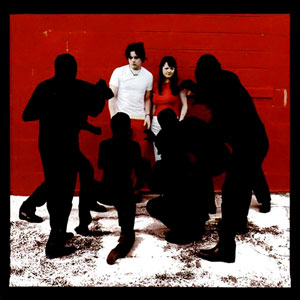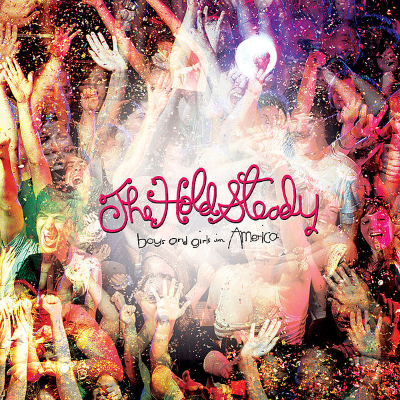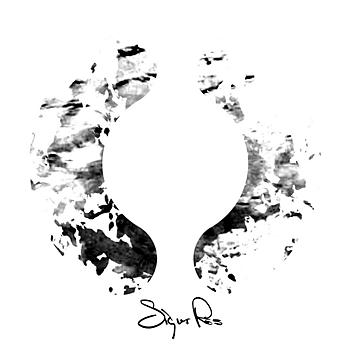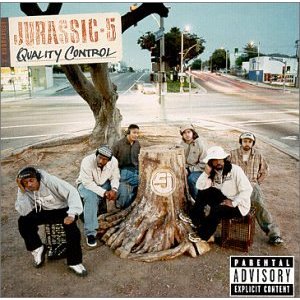 50. The White Stripes White Blood Cells (2001)
50. The White Stripes White Blood Cells (2001)
I was lucky enough to get into the White Stripes just before they hit it big, by hearing the band on college radio in Boston and seeing them play a small club just as White Blood Cells was being released. Jack and Meg White produced primal garage rock on the album, with short and sweet blasts of goodness throughout. Although released in mid-2001 on Sympathy for the Record Industry, it wasn’t until the album was re-released by V2 the following year that the mainstream began paying attention. “Fell in Love with a Girl” got some notice with a cool Lego-filled video directed by Michel Gondry and suddenly Jack and Meg and their color-coordinated look were everywhere. Powered simply by Jack’s raw guitar and Meg’s drum bashing, White Blood Cells runs the gamut: blues-rock bashing on “Dead Leaves and the Dirty Ground,” the country stomp of “Hotel Yorba,” the child-like wonder of “We’re Going to Be Friends.” Even better, the album set the stage for more interesting musical adventures courtesy of the prolific Mr. White. Koomdogg
49. The White Stripes Get Behind Me Satan (2005)
Working in piano, marimbas and mandolins, Get Behind Me Satan was a decisive departure for the White Stripes. Here, Jack and Meg began exploring significantly wider musical territory, and as diverse as its scope may be, Satan remains the most cohesive album in the band’s catalog. The band never truly abandons their gritty, bluesy Detroit roots (“Instinct Blues,” “Red Rain”). But the album also included sounds with more of a folksy flair (“Little Ghost,” “I’m Lonely (But I Ain’t That Lonely Yet)”) as well as more subdued acoustic/piano numbers (“As Ugly As I Seem,” “White Moon”), songs that wonderfully abuse the soft/loud dynamic (“The Nurse,” “Forever for Her is Over for Me”), and a string of accessible yet quirky rockers (“My Doorbell,” “The Denial Twist,” “Blue Orchid”). One of the albums unsung highlights is “Take Take Take,” which is probably the most interesting and incisive commentary on celebrity culture committed to record in the decade. It’s a diverse, dynamic, excellent album. Although some criticized it upon release fearing that Jack and Meg were veering to far off course musically, it remains my favorite White Stripes record. Dr. Gonzo
 48. The Hold Steady Boys & Girls In America (2006)
48. The Hold Steady Boys & Girls In America (2006)
The Hold Steady had been building indie rock momentum with its first two albums, 2004’s Almost Killed Me and 2005’s Separation Sunday, which featured frontman Craig Finn’s frenetic shout-singing and songs about youthful explorations of sex, religion and drugs. The band’s third album, 2006’s Boys and Girls in America, saw Finn doing more actual singing and including catchier hooks and choruses while still referencing recurring characters Holly and Charlemagne. “Stuck Between Stations” captured all these disparate elements in one terrific song, while “Massive Nights” and “Southtown Girls” made for great in-concert singalongs. Boys and Girls in America was The Hold Steady putting it all together, wrapping up the trilogy and really coming into its own as a rock band. Guitarist Tad Kubler was still a major presence, but keyboardist Franz Nicolay really stepped up to fill out the band’s sound. That, combined with the band’s killer live shows, put The Hold Steady in the upper echelon of rock acts in the ‘00s. Koomdogg
 47. Sigur Ros ( ) (2002)
47. Sigur Ros ( ) (2002)
Sigur Ros made a splash in the indie world with their breakthrough 1999 album, Ágætis byrjun. The Icelandic group was consistent with its 2002 follow up, but took their formula to another level of raw emotion and grandiose execution. ( ) was my first exposure to the band, and it was one of those rare moments – the ones that truly make you think “This is unlike anything that I’ve ever heard before.” When the album came out, a friend commented that it was like an aural representation of glacial movement. As abstract (and, I think, tongue-in-cheek) as that comment may have been, it fits ( ) very well. Truthfully, upon first listening to the album, I was taken aback by the laboriously slow tempo of most of the tracks. I remember thinking “I didn’t even know you could play rock music that.damn.slowly.” In part, that’s what makes the music so damn moving. In fact, I’d go so far as to say that for an album that comes to the listener with no blatantly encoded meaning, it’s a terribly emotional and meaningful record. The album has no real title; the songs have no titles; the lyrics are indecipherable, sung entirely in “Hopelandic,” a hodgepodge of Icelandic words and nonsense phonetics that were chosen purely for their aesthetic qualities. With this complete and utter lack of a direct message, Sigur Ros invite listeners to be participants in the music, actively creating their own associations based almost entirely on aural qualities fairly independent from other established systems of meaning. In that sense, ( ) feels like a very individualized, nearly private album that ends up being a screen onto which listeners project their own emotions and meanings. And it’s one of the decade’s most epic and most beautiful albums. Dr. Gonzo
46. Ne-Yo Year Of The Gentleman (2008)
When Ne-Yo’s Year Of The Gentleman dropped, I remember Big Money telling me that Ne-Yo must’ve gotten his heart broken something fierce. While the first two tracks are somewhat fast and your normal Ne-Yo kind of tracks, along with first single “Miss Independent,” the vibe changes soon thereafter. Most of the tracks are relationship based and tell somewhat of a story, like “Mad,” which is about a tug-of-war relationship that is going nowhere. But many of them are also about straight up heartbreak. On “Why Does She Stay,” Ne-Yo wonders why his girl stays with him through all of his faults. “Part Of The List” is about the intricate details he remembers about a previous girlfriend, down to how her face felt and her funny little laugh.
Maybe his most visual song is “Fade Into The Background,” in which he sings about watching his ex-girlfriend marry someone else. Nearly everyone has let someone get away. Ne-Yo took it to another level. “And now all I can do is smile, and fade into the background. I’ll say congratulations and I’ll fade into the background.” The song that related to me most though was “In the Way,” which was a bonus track for iTunes pre-orders. It’s about how forces seemingly get in the way of a relationship, making it unworkable. I think we’ve all been there. To me, if you’ve been in a relationship that has gone wrong for whatever reason, this is the album that you can relate to. While I may overrate it because of how much I relate to it, I think it’s his one masterpiece. GG
45. John Legend Once Again (2006)
If you polled a bunch of R&B fans and asked them which of John Legend’s albums was his best, I’d bet that the majority would answer his rookie album Get Lifted. It was a critical and commercial success and uplifted (pun intended) the R&B scene with a new voice. However, if you listen closely, his sophomore album Once Again is the stronger album, and it’s probably not all that close. Legend tells the sophomore jinx to get out of his face. He finds his groove as not only a writer, but also as a singer and producer. He co-wrote and co-produced a large bulk of the album and it has a smoky, vintage soul sound. It’s more of an adult sounding album than Get Lifted as well.
There’s no rapper to be found on this one. While “Save Room” was the first single, the killer track is “P.D.A (We Just Don’t Care).” It’s an early stages type love song in which Legend’s charm is amped up so high that it might even make you blush. “Each Day Gets Better” is Motown-inspired while “Where Did My Baby Go” is a piano-heavy ballad and Legend is at his best playing the keys. The last track is the beautiful “Coming Home,” which ends the album on the perfect note. GG
44. Converge Jane Doe (2001)
The first time I heard Converge’s Jane Doe album was driving around in a rental car in Boston. An artist I was traveling with at the time was singing Converge’s praises and had a copy of this album to play, so I threw it on. Hardcore was never my bag, but from what I had read and been told about Converge, they had a metallic sheen to their hardcore that piqued my curiosity. By the time we reached our destination, which happened to be a record store (Newbury Comics), I had my wallet out and was ready to plunk down some money to purchase this work of sheer genius that had just taken my eardrums to the woodshed and given them a delightful beating.
Jane Doe is a concept album of sorts based on a particularly unpleasant breakup that lead singer Jacob Bannon went through. I have no idea what in the hell this woman did to this man, but, like many before her in history, it inspired some amazing musical output. Casual listeners will mistake the album for nothing but a bunch of noise with screaming vocals, but the more informed and open-minded among us will hear an album that rides a wave of emotions from beginning to end. Seething hatred, menace, pain, sorrow, renewed anger, collapse, acceptance(?)…. they are all on display here in a whirlwind soundtrack of drums, bass, guitars and vocals that sound like that of a wounded animal (and I mean that as a compliment because the music wouldn’t work with any other type of vocal performance). The ability with which Converge conveys the emotions they needed to on this album is heretofore unmatched.
Let’s put it this way: if Nine Inch Nail’s The Downward Spiral had been written by a metallic hardcore band with the same level of musical genius as Trent Reznor, then Jane Doe would be the logical outcome.
This is album is not for the faint of heart, but if you consider yourself open to all types of music based purely on whether or not the artist delivers a powerful statement, then this album is well worth your time. This is not hardcore. This is not metal. This is art. (Also of note: when a band writes a landmark album like this, subsequent releases rarely come close to matching it. In Converge’s case, the three albums that have followed, You Fail Me, No Heroes and Axe To Fall stand skyscraper tall with Jane Doe. A rare and admirable feat.) Nick
43. Death Cab For Cutie Plans (2005)
You might not own this album, but I’m willing to bet you’ve at least heard the incredibly overplayed single,“I Will Follow You Into the Dark” at least a dozen times. Of course, the acoustic love song is famous for a reason: its depressing yet oddly romantic lyrics, paired with lead lead singer Ben Gibbard’s evocative vocals, characterize this 2005 release. Opening track “Marching Bands of Manhattan” is so damn cheerful and upbeat that you’ll have a hard time not wanting to dance along to it every time it plays. “Different Names for the Same Place” starts off quietly enough, but really packs its punch in the lyrics which deal with feeling like life is stagnant. Then there’s the poignant “What Sarah Said”, which holds one of the most hauntingly beautiful lyrics I’ve ever heard, “Love is watching someone die. So who’s gonna watch you die?” I feel like Plans is an often overlooked and underrated album, but it’s definitely one of my favorites from the 2000’s. Brittany
 42. Jurassic 5 Quality Control (2000)
42. Jurassic 5 Quality Control (2000)
As the ’90s drew to a close and we entered a new decade/millennium, the dominant paradigm of commercial hip hop was drenched in seemingly inescapable themes of misogyny, excess, wealth, big booties and designer liquor. Compounding this superficiality was the fact that there was very little happening in commercial hip hop that was musically interesting (these will be historically remembered as Puffy’s glory years). While hip hop had made incredible inroads into American culture in the preceding two decades, part of this evolution was also a loss of many of the principles and ideals that were so central to hip hop culture in the 1970s and early 1980s. Somewhat ironically, Jurassic 5 brought a refreshing approach to the genre by going back to hip hop’s heyday. Here, the lyrics weren’t so concerned with image and bling, but with positivity as well as love of the art form itself. Make no mistake – there’s plenty of braggadocio. But it centers around being the greatest MC in an unstoppable hip hop crew rather than how many bills you can flaunt or how many women you can objectify. As welcome as this throwback was in 2000, J5 backed themselves into an artistic corner, illustrating the challenges of taking up a retro sound. By the time the group released their follow up to Quality Control (2002’s Power in Numbers), it became painfully clear that a group can only take retro so far. By failing to evolve creatively, Jurassic 5 very quickly lost their foothold as one of the most interesting hip-hop groups at the beginning of the decade. Dr. Gonzo
41. The Flaming Lips Yoshimi Battles The Pink Robots
The Flaming Lips are a rare case of a band that had a limited cult following before shifting gears, successfully maintaining their cult following while also broadening their audience significantly. That transition began on 1999’s excellent The Soft Bulletin, but really came to a tipping point with Yoshimi Battles the Pink Robots. The band’s musical blend of psychedelia, art rock and indie pop sensibilities (with a good deal of electronic flourishes) merge to produce one of the most consistent, emotional and simply gorgeous albums of the decade. The melodies are exquisite, complemented by lyrics that range from melancholy (“It’s Summertime,” “All We Have is Now”) to sci-fi (“One More Robot,” “Yoshimi Battles the Pink Robots”) to waxing philosophical (“Do You Realize?”). Yoshimi is one of those albums that is so perfectly crafted; every piece seems to be in its right place, and it’s difficult to imagine this unified whole in any way other than how it was released. A decade later, it still sounds fresh, the music is still compelling and the lyrics still prompt the listener to think and look inward. The sort of self-reflection that Yoshimi produces makes it unique, and I predict will allow the album to maintain its cultural currency for decades more. Dr. Gonzo


2 comments
blerd says:
Feb 15, 2012
Nice job, guys. I own and love pretty much all of these albums. “()” is the only time I’ve been able to fully dig Sigur Ros. Generally speaking, they’re a little weird for me.
Gonzo says:
Feb 16, 2012
Yeah, this is a dynamite chunk. I’m surprised that the White Stripes albums are back to back.
Also, I stopped paying attention to Sigur Ros after (). Seemed to be more of the same.